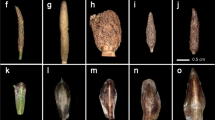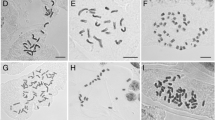Abstract
Carex (Cyperaceae) is one of the largest genera of the flowering plants, and comprises more than 2,000 species. In Carex, section Siderostictae with broader leaves distributed in East Asia is thought to be an ancestral group. We aimed to clarify the phylogenetic relationships and chromosomal variations within the section Siderostictae, and to examine the relationship of broad-leaved species of the sections Hemiscaposae and Surculosae from East Asia, inferred from DNA sequences and cytological data. Our results indicate that a monophyletic Siderostictae clade, including the sections Hemiscaposae, Siderostictae and Surculosae, as the earliest diverging group in the tribe Cariceae. Low chromosome numbers, 2n = 12 or 24, with large sizes were observed in these three sections. Our results suggest that the genus Carex might have originated or relictly restricted in the East Asia. Geographical distributions of diploid species are restricted in narrower areas, while those of tetraploid species are wider in East Asia. It is concluded that chromosomal variations in Siderostictae clade may have been caused by polyploidization and that tetraploid species may have been able to exploit their habitats by polyploidization.


Similar content being viewed by others
References
Ball PW, Reznicek AA (2002) Carex. In: Flora of North America Editorial Committee (ed) Flora of North America North of Mexico, vol 23: Magnoliophyta, Commelinidae (in part), Cyperaceae. Oxford University Press, New York, pp 254–572
Dai LK, Liang SY, Zhang S, Tang Y, Koyama T, Tucker GC (2010) Carex L. In: Wu Z-Y, Raven PH, Hong D (eds) Flora of China, vol 23. Science Press, Beijing and Missouri Botanical Garden Press, St. Louis, pp 285–461
Egorova TV (1999) The sedges (Carex L.) of Russia and adjacent states (within the limits of the former USSR). St. Petersburg State Chemical-Pharmaceutical Academy, St. Petersburg and Missouri Botanical Garden, St. Louis
Felsenstein J (1985) Confidence limits on phylogenies: an approach using the bootstrap. Evolution 39:783–791
Fitch WM (1971) Toward defining the course of evolution: minimum change for a specific tree topology. Syst Zool 20:406–416
Grant VE (1981) Plant speciation, 2nd edn. Columbia University Press, New York
Hipp AL, Rothrock PE, Roalson EH (2009) The evolution of chromosome arrangements in Carex (Cyperaceae). Bot Rev 75:96–109
Hoshino T (1981) Karyomorphological and cytogenetical studies on aneuploidy in Carex. J Sci Hiroshima Univ, ser. B, Div 2 Bot 17:155–238
Hoshino T, Masaki T (2011) Illustrated sedges of Japan. Heibonsha, Tokyo (in Japanese with English description)
Hoshino T, Tanaka R (1977) Karyomorphological studies of Carex siderosticta and its two allied species. La Kromosomo II 7–8:191–194
Hoshino T, Okamura K, Hong D-Y, Dai L-K, Nakata M, Tanaka R (1993) Cytological studies of chinese Cyperaceae (1). Chromosome counts of nine species collected from Jilin, Liaoning and Hebei provinces. J Jpn Bot 68:65–69
Hsiao C, Chatterton NJ, Asay KH, Jensen KB (1994) Phylogenetic relationships of 10 grass species: an assessment of phylogenetic utility of the internal transcribed spacer region in nuclear ribosomal DNA in Monocots. Genome 37:112–120
Koyama T (1962) Classification of the family Cyperaceae (2). J Fac Sci Univ Tokyo, Sect. 3 Bot 8:149–278
Kükenthal G (1909) Cyperaceae-Caricoideae. In: Engler A (ed) Das Pflanzenreich IV Heft 38. Wilhelm Engelmann, Leipzig, pp 1–824
Levin DA (1983) Polyploidy and novelty in flowering plants. Am Nat 122:1–25
Roalson EH (2008) A synopsis of chromosome number variation in the Cyperaceae. Bot Rev 74:209–393
Roalson EH, Columbus JT, Friar EA (2001) Phylogenetic relationships in Cariceae (Cyperaceae) based on ITS (nrDNA) and trnT-L-F (cpDNA) region sequences: assessment of sub generic and sectional relationships in Carex with emphasis on section Acrocystis. Syst Bot 26:318–341
Sharma AK, Sharma A (1980) Chromosome techniques. Theory and practice, 3rd edn. Butterworths, London, p 55
Swofford DL (2002) PAUP*: Phylogenetic analysis using parsimony (* and other methods), version 4.0b 10. Sinauer Associates, Massachusetts
Starr JR, Ford BA (2009) Phylogeny and evolution in Cariceae (Cyperaceae): current knowledge and future directions. Bot Rev 75:110–137
Starr JR, Bayer RJ, Ford BA (1999) The phylogenetic position of Carex section Phyllostachys and ITS implication for phylogeny and subgeneric circumscription in Carex (Cyperaceae). Am J Bot 86:563–577
Starr JR, Harris SA, Simpson DA (2004) Phylogeny of the uni-spicate taxa in Cyperaceae tribe Cariceae I: generic relationships and evolutionary scenarios. Syst Bot 29:528–544
Starr JR, Harris SA, Simpson DA (2008) Phylogeny of the uni-spicate taxa in Cyperaceae tribe Cariceae II: the limits of Uncinia. In: Naczi RFC, Ford BA (eds) Sedges: uses, diversity and systematics of the Cyperaceae. Monographs in systematic botany from the Missouri Botanical Garden, Saint Louis, pp 243–267
Taberlet P, Gielly L, Pautou G, Bouvet J (1991) Universal primers for amplification of three non-coding regions of chloroplast DNA. Plant Mol Biol 17:1105–1109
Tanaka N (1939) Chromosome studies in Cyperaceae IV. Chromosome number of Carex species. Cytologia 10:51–58
Tanaka N (1940) Chromosome studies in Cyperaceae, VIII. Meiosis in diploid and tetraploid forms of Carex siderosticta hance. Cytologia 11:282–310
Tanaka N (1948) The problem of aneuploidy. Biological contribution in Japan. Hokuryukan, Tokyo (in Japanese)
Tang Y-C, Xiang G-Y (1989) A cytological study of Carex siderosticta hance (Cyperaceae) and its implication in phytogeography. Cathaya 1:49–60
Thompson JD, Lumaret R (1992) The evolutionary dynamics of polyploid plants—origins, establishment and persistence. Trends Ecol Evol 7:302–307
Thompson JD, Higgins DG, Gibson TJ (1994) ClustalW: improving the sensitivity of progressive multiple sequence alignment through sequence weighting, position-specific gap penalties and weight matrix choice. Nucleic Acids Res 22:4673–4680
Waterway MJ, Starr JR (2007) Phylogenetic relationships in tribe Cariceae (Cyperaceae) based on nested analyses of four molecular data sets. Aliso 23:165–192
Waterway MJ, Hoshino T, Masaki T (2009) Phylogeny, species richness, and ecological specialization in Cyperaceae tribe Cariceae. Bot Rev 75:138–159
White TJ, Bruns T, Lee S, Taylor J (1990) Amplification and direct sequencing of fungal ribosomal RNA genes for phylogenetics. In: Innis MA, Gelfand DH, Sninsky JJ, White TJ (eds) PCR protocols, a guide to methods and applications. Academic Press, New York, pp 315–322
Yano O, Katsuyama T, Hoshino T (2008) Cytological studies of Japanese Carex (Cyperaceae) I. J Jpn Cyperol 13:9–21 (in Japanese with English abstract)
Yano O, Ikeda H, Watson MF, Rajbhandari KR, Jin XF, Hoshino T, Muasya AM, Ohba H (2012) Phylogenetic position of the Himalayan genus Erioscirpus (Cyperaceae) inferred from DNA sequence data. Bot J Linn Soc 170:1–11
Yen AC, Olmstead RG (2000) Molecular systematics of Cyperaceae tribe Cariceae based on two chloroplast DNA regions: ndhF and trnL intron-intergenic spacer. Syst Bot 25:479–494
Acknowledgments
The authors thank Ms. Satoe Yoshioka and Mr. Yoshitaka Yukie for their great help in this study. This study was partly supported by a Grant-in-Aid for Scientific Research (A) no. 23255005 (to H. I.), (C) no. 21570103 (to T. H.), and a Grant-in-Aid for Young Scientists (B) no. 25840136 (to O. Y.), from the Japan Society for the Promotion of Science.
Author information
Authors and Affiliations
Corresponding author
Rights and permissions
About this article
Cite this article
Yano, O., Ikeda, H., Jin, XF. et al. Phylogeny and chromosomal variations in East Asian Carex, Siderostictae group (Cyperaceae), based on DNA sequences and cytological data. J Plant Res 127, 99–107 (2014). https://doi.org/10.1007/s10265-013-0578-y
Received:
Accepted:
Published:
Issue Date:
DOI: https://doi.org/10.1007/s10265-013-0578-y




